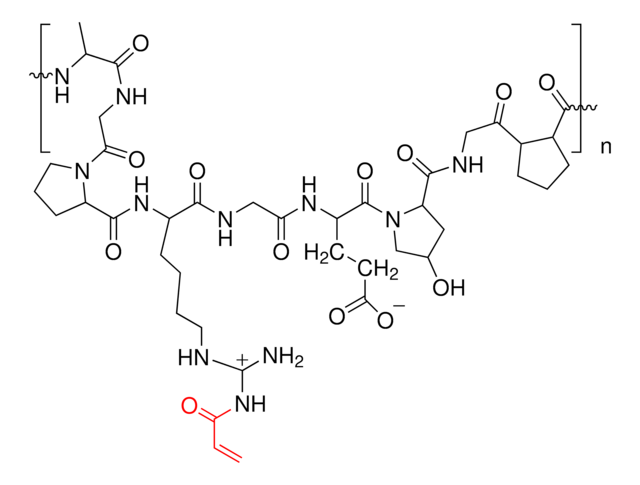900629
Gelatin methacryloyl
gel strength 300 g Bloom, degree of substitution 40%
Synonym(s):
GelMa, Gelatin Methacrylate, Gelatin methacrylamide
Sign Into View Organizational & Contract Pricing
All Photos(2)
About This Item
Linear Formula:
(C40H59N11O13)n
UNSPSC Code:
12352202
NACRES:
NA.23
Recommended Products
Looking for similar products? Visit Product Comparison Guide
Related Categories
Application
Gelatin-methacrylate can be used to form crosslinked hydrogels for tissue engineering and 3D printing. It has been used for endothelial cell morphogenesis, cardiomyocytes, epidermal tissue, injectable tissue constructs, bone differentiation, and cartilage regeneration. Gelatin-methacrylate has been explored in drug delivery applications in the form of microspheres and hydrogels.
Storage Class Code
11 - Combustible Solids
WGK
WGK 3
Flash Point(F)
Not applicable
Flash Point(C)
Not applicable
Certificates of Analysis (COA)
Search for Certificates of Analysis (COA) by entering the products Lot/Batch Number. Lot and Batch Numbers can be found on a product’s label following the words ‘Lot’ or ‘Batch’.
Already Own This Product?
Find documentation for the products that you have recently purchased in the Document Library.
Customers Also Viewed
Preparation and characterization of gelatin-poly(methacrylic acid) interpenetrating polymeric network hydrogels as a pH-sensitive delivery system for glipizide.
Gupta NV et al.
Indian Journal of Pharmaceutical Sciences, 69(1), 64-68 (2007)
Anh H Nguyen et al.
Acta biomaterialia, 13, 101-110 (2014-12-03)
Gelatin has been commonly used as a delivery vehicle for various biomolecules for tissue engineering and regenerative medicine applications due to its simple fabrication methods, inherent electrostatic binding properties, and proteolytic degradability. Compared to traditional chemical cross-linking methods, such as
Xin Zhao et al.
Advanced healthcare materials, 5(1), 108-118 (2015-04-17)
Natural hydrogels are promising scaffolds to engineer epidermis. Currently, natural hydrogels used to support epidermal regeneration are mainly collagen- or gelatin-based, which mimic the natural dermal extracellular matrix but often suffer from insufficient and uncontrollable mechanical and degradation properties. In
Chaenyung Cha et al.
Biomacromolecules, 15(1), 283-290 (2013-12-19)
Microfabrication technology provides a highly versatile platform for engineering hydrogels used in biomedical applications with high-resolution control and injectability. Herein, we present a strategy of microfluidics-assisted fabrication photo-cross-linkable gelatin microgels, coupled with providing protective silica hydrogel layer on the microgel
Kelly M C Tsang et al.
Advanced functional materials, 25(6), 977-986 (2015-09-04)
Hydrogels are often employed as temporary platforms for cell proliferation and tissue organization in vitro. Researchers have incorporated photodegradable moieties into synthetic polymeric hydrogels as a means of achieving spatiotemporal control over material properties. In this study protein-based photodegradable hydrogels
Our team of scientists has experience in all areas of research including Life Science, Material Science, Chemical Synthesis, Chromatography, Analytical and many others.
Contact Technical Service








